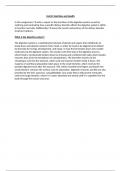Unit 8: Nutrition and Health
In this assignment, I'll write a report on the functions of the digestive system as-well as
outlining and contrasting how a specific dietary disorder affects the digestive system's ability
to function normally. Additionally, I'll assess the results and potency of the dietary disorder
treatment options.
What is the digestive system?
The digestive system is a sophisticated network of glands and organs that collaborate to
break down and absorb nutrients from meals. In order for food to be digested and utilised
by the body for energy, development, and repair, it must first be broken down into smaller
molecules via the digestive system. The mouth is the first stop in the digestive process,
where food is mechanically broken down by chewing and combined with saliva that includes
enzymes that aid in the breakdown of carbohydrates. The food then travels via the
oesophagus and into the stomach, where acid and enzymes further break it down. The
majority of nutritional absorption takes place in the small intestine, which receives the
partially digested meal after the stomach. Villi, which resemble tiny fingers and border the
small intestine, enhance the surface area for absorption. Digestive enzymes and bile are also
provided by the liver, pancreas, and gallbladder. Any waste that is still present eventually
enters the large intestine, where it is water-absorbed and stored until it is expelled from the
body through the rectum and anus.
,P5:
,Functions of parts of the digestive system:
The digestive system is a sophisticated system that disintegrates food into tiny pieces so that
the body can absorb and utilise them. The function of each organ and the digestive fluids
that are connected to it are described in depth below:
Stomach: An important part of the digestive system is the stomach, a muscular sac in the
upper abdomen. Prior to food entering the small intestine for additional digestion and
absorption, it stores and breaks down food. Food is combined with digestive juices and
enzymes released by the stomach walls when it enters the stomach. These digestive juices
and enzymes, which include hydrochloric acid, pepsinogen, and mucus, are produced by the
gastric glands, which are found in the stomach lining. By dissolving food proteins and
generating an acidic environment in the stomach that is necessary for the activation of other
digestive enzymes, hydrochloric acid plays a significant role in the digestion process. The
main cells in the stomach lining create pepsinogen, which is activated by the acidic
environment and transforms into pepsin, which aids in the breakdown of proteins into
smaller amino acids. The goblet cells in the stomach lining secrete mucus, which helps to
shield the stomach lining from the corrosive effects of the digestive juices' acidity. Chyme is a
semi-liquid combination that is created when the muscles of the stomach wall flex,
combining the meal with the digestive juices and enzymes. The pyloric sphincter, a muscle
valve at the base of the stomach, then allows the chyme to be discharged in minute
amounts into the small intestine. The stomach not only aids in the breakdown of food but
also aids in the absorption of various nutrients, including alcohol and some medications. It
also acts as a temporary food storage space, enabling the body to gradually digest and
absorb nutrients. All things considered, the stomach is an essential component of the
digestive system since it serves as the site for the early digestion and processing of food.
, Mouth: The mouth is a crucial starting point in the digestive system and is responsible for
breaking down food. Its main purpose is to use chewing and grinding to mechanically break
down food, which increases its surface area, making it easier to digest. Saliva is the digestive
juice that the mouth secretes. It contains enzymes that begin the chemical breakdown of
carbohydrates. Amylase, one of the enzymes present in saliva, breaks down starches into
simpler sugars like glucose and maltose. This chemical process starts in the mouth and
continues in the small intestine. After food is chewed and mixed with saliva, it becomes a
soft, moist mass called a bolus, which is easy to swallow. The tongue and mouth muscles
work together to move the bolus towards the back of the throat and into the oesophagus,
which leads to the stomach. The mouth also has a role in taste, which can affect the
digestive process. Taste buds in the tongue and other mouth areas detect different flavours
and transmit signals to the brain, which can stimulate the release of digestive juices in
preparation for food. To sum up, the mouth is the digestive system's starting point and is
responsible for mechanically breaking down food through chewing and grinding and
chemically through the presence of enzymes like amylase in saliva. Additionally, the mouth
plays a role in taste, which can impact the digestive process by initiating the release of
digestive juices.





